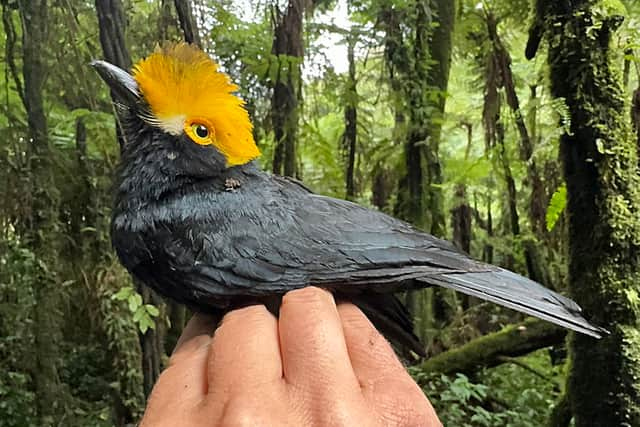Yellow-crested helmetshrike: First ever pictures as bird feared extinct for 20 years rediscovered
and live on Freeview channel 276
Scientists have managed to capture photos of a golden-crowned bird feared extinct after more than 20 years without being seen.
The first-ever picture of a yellow-crested helmetshrike, listed as 'lost' by the American Bird Conservancy, was taken during a recent expedition led by University of Texas at El Paso researchers. Scientists spent six weeks trekking 75 miles through the Itombwe Massif, a mountain range in eastern Democratic Republic of the Congo, studying birds, amphibians, and reptiles along the way.
Advertisement
Hide AdAdvertisement
Hide AdThe photos of the helmetshrikes have now been reviewed and confirmed by the conservancy's lost birds project. Ornithologist Dr Michael Harvey, who was on the expedition, said coming across the birds was a "mind-blowing experience", after two decades with no sightings.


"We knew they might be possible here, but I was not prepared for how spectacular and unique they would appear in life,” Dr Harvey continued. The researches stumbled upon a rather "noisy and active" group of the striking black birds - which have vivid yellow 'helmets' - while exploring the cloud forests on the slopes of a mountain, he continued. In total, about 18 birds were found at three sites during the trip.
The yellow-crested helmetshrike, scientific name Prionops alberti, is endemic to the western slopes of the Albertine Rift of Central Africa. However, Dr Harvey said the region has historically been largely inaccessible due to war and security issues, but has recently become safer to visit.
The Democratic Republic of the Congo is the most biologically diverse country in Africa, and is home to more than half of the continent's tropical forests, according to the WWF. It is home to more than 15,000 plant and animal species, including more than 3,200 species only found there - including a host of spectacular birds like the Congolese peacock.
Advertisement
Hide AdAdvertisement
Hide Ad“This inspires hope that perhaps the species still has a reasonably healthy population in the remote forests of the region,” Dr Harvey continued. “But mining and logging as well as the clearing of forests for agriculture are making inroads deep into the forests of the Itombwe range. We are in discussions with other researchers and conservation organizations to further efforts to protect the region’s forests and the helmetshrike.
“Right now is a golden opportunity to protect these tropical forests, so that we don’t lose species like the helmetshrike before they are known and studied.”
Comment Guidelines
National World encourages reader discussion on our stories. User feedback, insights and back-and-forth exchanges add a rich layer of context to reporting. Please review our Community Guidelines before commenting.
